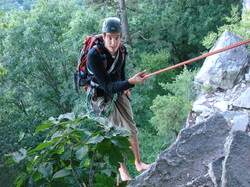How to Set Up a Rappel:

- First things first: get yourself secured. Let's not forget that you are probably working at the top of a cliff. Even if you feel comfortable and safe on a nice ledge, don't forget that any slip or fall will probably be the end of you. Secure yourself into whatever gear you have at the top of the climb. Use a runner that is girth hitched to your harness (through the two loops between your legs that your rope runs through) and a locking carabiner to clip into the bolts with the rap rings/chains/etc. Inspect the bolts and the rings/chains/etc for rust, wear, integrity. No fixed protection? If you have some active or passive pro, place a piece or anchor yourself to a solid tree or boulder. Review our articles on passive pro, active pro and natural pro if you are unsure about this. You can also use a figure 8 on a bight or a clove hitch on the climbing rope to secure yourself at the top of the climb.
- Alright, now you are ready to consider the anchor. The anchor that you set for your rappel will depend on the resources available at the crag that you are at. Many popular crags will have rap rings or chains at the top of the cliff band to make the descent easy. You always want to rappel through rings or chains rather than bolts because chains and rings are smooth while bolts have abrasive edges that will damage your rope. Always be sure to check their integrity since you do not know who placed them or when. Rap chains are most often connected to bolts that are drilled into the rock. Inspect the bolts: do they spin? do they look rusty or brittle? If so, consider setting your own anchor with some webbing. Is the bottom chain link or the rap ring worn down? Be sure to know the basic principles of anchors and how to set a trad anchor so you can set your own in a pinch.
- Now you need to attach your rope to your anchor. This usually involves running one end of the rope through your rap rings (or chains) until the middle of the rope hangs between the two points. If possible, try to keep this end of the rope and all the slack on the ledge with you to prevent it from sluffing off down the cliff and getting caught in a crack/tree/etc. If you are rapping off a pair of opposite and opposed carabiners or a locking carabiner, then you can just clip the middle of the rope into the biners.
- Always, tie stopper knots in both ends of your rope. You can use a variety of knots in order to create the "stopper" effect, but the stopper knot itself is essentially the same knot used to back up a double figure eight, or one half of a double fisherman's. The stopper knot's purpose is to ensure that the end of the rope does not pass through your belay device, thus preventing you from hitting the deck in the event that your rope is too short for the rappel. "But what if I know my rope is long enough?" You might be asking right now. We suggest that you ALWAYS ALWAYS ALWAYS tie a stopper knot at the end of your rope to GET IN THE HABIT. If you cultivate good habits from the beginning, you will be less likely to forget to tie a stopper knot when your rope is not long enough. One of the most common causes of climber fatality is rapping off the end of the rope! Get in a good habit now so you don't become another statistic!
- Now you need to get the rest of the rope down off the cliff edge without knotting or getting hopelessly caught. Make sure both ends of your rope are flaked. We suggest throwing each half of the rope on its own, coiled separately, off the cliff. Some throw both halves at the same time, but we've found they are more prone to tangling. Make sure there are no knots that will hold you up half way through the rappel. With your rope in hand and your personal anchor still secure, lean out over the cliff edge and inspect the landing: Is there a puddle of water? a tree? a sleeping infant? If so, then be sure to try to avoid the hazards when tossing your rope. In the case of a sleeping infant, holler out to find a parent so they can move the baby. More likely, it will be a clueless climber hanging out at the bottom of the crag - just yell (politely at him/her) to get out of the way. Immediately before tossing your first half of the rope, shout out "ROPE!" Toss that sucker, being careful to avoid any hazards and to maintain your stability on top of the cliff. Toss your second half in the same fashion, yelling "rope" and all. If there is a tree that you are worried your rope will get caught in don't look at the tree! If you look at the tree while you are throwing, you will invariably throw the rope into the branches. If your rope gets slightly tangled or caught on the way down, don't stress. Flick the rope a few times, and if it was properly flaked, it should work itself out. If it doesn't, you can always deal with it as you rappel down, though this is less than ideal.
- Now that your rope is secured, you need to attach yourself to the system. For beginning rock climbers, it is most common to rappel through a Black Diamond (BD) ATC, ATC-XP or a Petzl GriGri. Follow the instructions that came with your belay device on how to load the rope for a rappel. Regardless on the model, the belay device should attach to your belay loop on your harness via a locking carabiner and the the rope should feed in one side and out the other. You will be providing your own belay on the way down. In order to do this, place both hands on the rope about 6" down from where the rope exits the belay device. To brake the rope, hold your hand firmly at your hip so that the friction from the belay device arrests the rope. Once the rope is fed through the belay device attached to your harness and you are giving yourself a good brake, you are secure into the rappelling system.
- DOUBLE CHECK EVERYTHING. Is the anchor secure? Are ALL of your locking carabiners in the system locked off? Is the rope fed through the belay device properly? Is your harness double-backed? Do you have everything you need off the cliff ledge (ex: water bottle, sunglasses)?
- If your partner is down at the base of the cliff, let them know that you are about to rappel. They can give you a FIREMAN'S BELAY from below by simply holding both ends of the rope. In the event of you having a seizure, out of body experience, getting attacked by a bald eagle, or getting hit in the head by a rock, they simply need to pull down on the rope and this will arrest the rope through your belay device.
- Allright, now you can remove your personal anchor from step 1 while maintaining your hand brake on the belay device. You are ready for the ride. Lower yourself slowly by feeding rope through the belay device. Lift up slowly to release tension and let it slide through the device at the speed that you feel comfortable. If you are on a steep to vertical wall, lower your butt first so that your legs are elevated out in front of you as if you are sitting on a couch with your feet up on a coffee table. Slowly walk down with your feet, being sure to look beneath you to scout out good footholds.
- Rappelling is fun! HAVE FUN!

